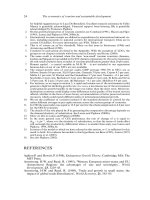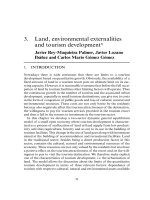THE ECONOMICS OF MONEY,BANKING, AND FINANCIAL MARKETS 152
Bạn đang xem bản rút gọn của tài liệu. Xem và tải ngay bản đầy đủ của tài liệu tại đây (218.81 KB, 1 trang )
120
PA R T I I
Financial Markets
FINANCIAL NEWS
Yield Curves
The Wall Street Journal publishes a daily plot of
the yield curves for U.S. Treasury securities, an
example of which is presented here. It is found in
the Money and Investing section. The Globe and
Mail: Report on Business publishes similar yield
curves for Government of Canada securities.
The numbers on the vertical axis indicate the
interest rate for the U.S. Treasury security, with
the maturity given by the numbers on the horizontal axis.
*Semiannual swaps maturing in 2 yrs-30 yrs
Sources: Ryan ALM; ICAP plc.
Source: Wall Street Journal, Wednesday, January 21, 2009, p. C4.
yield curves for U.S. Treasury securities that were published in the Wall Street
Journal. Similar yield curves are reported for Canada in the Globe and Mail: Report
on Business. Yield curves can be classified as upward-sloping, flat, and downwardsloping (the last sort is often referred to as an inverted yield curve). When yield
curves slope upward, as in the Financial News box, the long-term interest rates are
above the short-term interest rates; when yield curves are flat, short- and long-term
interest rates are the same; and when yield curves are inverted, long-term interest
rates are below short-term interest rates. Yield curves can also have more complicated shapes in which they first slope up and then down, or vice versa. Why do
we usually see upward slopes of the yield curve?
Besides explaining why yield curves take on different shapes at different times,
a good theory of the term structure of interest rates must explain the following
three important empirical facts:
1. As we see in Figure 6-4, interest rates on bonds of different maturities move
together over time.
2. When short-term interest rates are low, yield curves are more likely to have an









